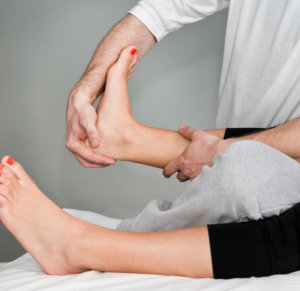Cuboid syndrome is a displacement of the cuboid bone from the rest of the foot and ankle complex.
This injury happens secondary to trauma or repetitive stresses. Due to impact, the ligaments around the cuboid can get injured and cause a slippage of the cuboid. This syndrome is marked by lateral foot pain.
Risk Factors for Cuboid Syndrome
 Individuals that participate in high impact sports, dance, running, and/or are overweight have an increased likelihood to develop cuboid syndrome. Additionally, wearing shoes without appropriate support and exercising on uneven surfaces can lead to this syndrome.
Individuals that participate in high impact sports, dance, running, and/or are overweight have an increased likelihood to develop cuboid syndrome. Additionally, wearing shoes without appropriate support and exercising on uneven surfaces can lead to this syndrome.
These all place excess and repetitive stress on the foot and ultimately the cuboid.
Symptoms of Cuboid Syndrome
Symptoms may happen acutely or gradually increase. Typical characteristics include:
- Pain focal to the lateral foot
- Pain increases with weight bearing
- Pain can be sharp acutely, or dull and aching
- Pain with walking
- Jumping is difficulty
- Swelling to the lateral column of the foot/ankle
- Decreased range of motion to the ankle
Causes of Cuboid Syndrome
Overuse
Overuse is the most common cause of cuboid syndrome. This happens with repetitive movements like running or dancing. These sports require significant pressure on the feet and many repetitions of the same movements.
Sprained Ankle
Inversion sprains of the ankle are correlated with the potential for cuboid syndrome development. Inversion sprains are when an individual rolls over the outside of their foot. While less common, eversion sprains are still associated with potential cuboid syndrome development. Eversion sprains are when an individual rolls over the medial border of their foot.
Flat Feet
When an individual has flat feet, the arches tend to collapse due to decreased ligamentous integrity. This lack of ligamentous stability predisposes one to a potential collapse of the cuboid.
Treating Cuboid Syndrome
The first line of defense is rest from the activities that trigger the pain, ice, compress, and elevate the foot.
If the pain does not go away on its own, you should seek medical help. If you visit a physical therapist or chiropractor they may perform a cuboid whip to help reduce the cuboid into its proper position.
Tape may be placed to help maintain position. Additionally, foot intrinsic strengthening, balance work, and stretching activities to the calf/ foot can help improve the muscular integrity of the foot.
